Are You also curious and fascinated by the mythical Anaconda snake? Well You’ve reached the right place! We’ve gathered for you a unique collection of Facts, Tales and Studies covering this riveting snake.
So let’s start…
The Anaconda quick Pitch
The giant Anaconda is a brutal meat-eater, and a natural predator. This mythical snake of gigantic proportions is found throughout tropical South America, east of the Andes, mainly in the Amazon and Orinoco Basins. It is regarded as the largest and heaviest snake in the World, reaching lengths of more than 6.6m, (22 ft) and weights of up to 70 kg (154 lb).
Are Anacondas Boas or Pythons?

This is one of the most asked questions, and among our primary Anaconda facts. Well, these huge beautiful snakes are members of the Boa Family, which is a family of non-venomous snakes found in America, Africa, Europe, Asia and a few Pacific Islands. Known to be diverse and relatively primitive snakes, the Boa Family includes two sub-families, composed of 8 genera and 43 recognized species.
Where did Anacondas get their powerful name from?
Some claim the name “anaconda” originates from the Tamil word “anaikolra”, which means “elephant killer.” The first and main word of the Common Anaconda’s scientific name, Eunectes murinus, means “good swimmer”. Others claim that the word “Anaconda” is derived from the name of a snake from Sri Lanka that was described in 1693 by John Ray as Serpens indicus bubalinus anacandaia zeylonibus. Another interesting fact about the ‘name’ issue, is that despite the Anaconda is only found in South America, the name that is commonly used for it in Brazil is actually “Sucuri”, “Sucuriju” or “Sucuriuba”.
HOW MANY ANACONDA SPECIES ARE THERE?
Although the name ‘Anaconda’ applies to a group of four snake species, it usually refers only to one species in particular, the Green Anaconda. However, there are 3 other different types of anacondas: The Yellow Anaconda, the Dark-spotted Anaconda and the Bolivian Anaconda.
Quick Green Anaconda Facts
Named Eunectes murinus or Common Anaconda, the Green Anaconda is regarded as the heaviest snake in the world. It can weigh as much as 227 kg (550 lbs). It can reach extraordinary lengths of 9 meters (30 feet) or more which is only slightly less than the longest snake in the world; the Reticulated Python. There are many more fascinating Green Anaconda Facts down below, but first let’s get to know his other uncles…
Quick Yellow Anaconda Facts
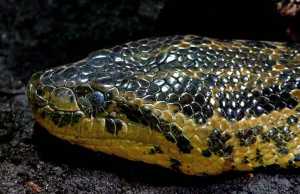
This beautiful Anaconda is also known as Eunectes notaeus. It is smaller than the Green Anaconda, with an average length of 3.5-4.5 meters (11-14 feet). Its colors range from yellow to light green, with black or brown patches and streaks. Interestingly, the Yellow Anaconda prefers to live in the regions of South America that are further south than the Green Anaconda.
Quick Dark-Spotted Anaconda Facts
This dark Anaconda is also known as Eunectes deschauenseei. It has almost the same measures (weight and length) as the yellow anaconda, but is brown in color, with large dark spots scattered on its body.
The Dark-Spotted Anaconda is regarded as a fairly rare species, and is not so common as his Green and Yellow uncles. This Anaconda’s habitat is focused in French Guiana and northern Brazil.
Quick Bolivian Anaconda Facts
This unique Anaconda, known also as Eunectes beniensis, is even more rare than its Dark-Spotted uncle. It was only discovered in 2002, so very little is known about this Anaconda, which can only be found in Bolivia. Its color design is brown with black spots scattered across its body.
IS THE ANACONDA A HOLLYWOOD MOVIE STAR?
If you’re a movie freak, you surely know the 1997 adventure-horror film, “Anaconda”, starring Jennifer Lopez and other big stars. The film, which despite negative reviews became a box office hit, revolves around a National Geographic crew that has been taken hostage by a Snake Hunter who is determined to find the legendary Giant Anaconda in the Amazon Rainforest.
If you’ve never heard of it, take a look at the Trailer:
Where are Anacondas found?
As mentioned, Anacondas can be found in the tropical rainforests of South America, mainly in marshes and swamps. They spend most of their time floating and diving underwater, in search for prey. When they want to dry off, they will hang from tree branches.
Anaconda Distribution Map
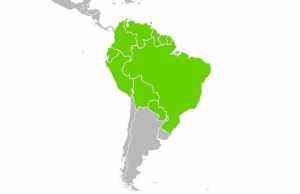
Are Anacondas venomous?
You might be surprised, but the largest Snake in the World is not venomous.
How do Anacondas hunt?
Despite being a non-venomous snake, the Anaconda can hunt and devour huge animals, using constriction to subdue its prey. As mentioned, most of the Anaconda’s time is spent in the water, where it uses both sight and smell to hunt. It also has the ability to sense heat emitted by potential prey.
Once the Anaconda locates a target, it will grab the animal in its jaws and lock it in with its teeth. The anaconda will then coil around the prey and squeeze it slowly and patiently until the animal is suffocated to death. The Anaconda will then consume the prey whole. After a nice big meal, Anacondas can survive for weeks without eating again.
When the prey is larger than usual, lets say a big deer, the Anaconda can unhinge its jaw and stretch its mouth around the body of the deer.
When do Anacondas hunt?
Since the giant Anaconda snake is a nocturnal animal, this means that it more active during the dark of night. It can hunt both on land and water, although it prefers the water since it is much more maneuverable there.
What do Anacondas eat?
Basically, this mythical snake can be found eating almost anything it can overpower and devour into his huge body. When it hunts for smaller meals, the Anaconda will usually eat up to 40 pounds of prey per day. His spectacular menu includes birds, fish, pigs, rodents, other reptiles such as turtles, caimans, and even large animals like deer. Some experts claim the Anaconda is the only predator that is strong enough to hunt a Jaguar. Some claim the Anaconda is also a man-eater.
Do Anacondas eat people?
This is among the most asked about Anaconda facts. People are afraid of the largest snake in the world, that’s natural. And if we look at its huge body dimensions and powerful constricting techniques, there’s no doubt that the Anaconda can definitely eat a human adult. However, there are no verified reports of Anacondas that have eaten a human being yet. You have surely heard of Discovery channel’s epic TV episode of “Man Eaten Alive” by an Anaconda. If not – take a look at the trailer:
Are Anacondas Cannibals?
There have been reports of female green anacondas, during mating season (April through May), constricting and eating weaker male anacondas, which are usually smaller than the females.
Do Anacondas vomit?
This is definitely among our favorite Anaconda facts. Surprisingly, vomiting is quite common among Anacondas. What’s the reason? Well, a huge meal such as a deer will usually immobilize the Anaconda. All their powerful digestive systems are working in full-power, making the Anaconda slow and heavy. Then, if some sort of danger appears, the Anaconda needs to regain its quickness, so what does it do? Yes, it vomits the huge prey, in order to move fast, sneak away, hide or fight.
Watch this riveting video of an Anaconda vomiting a cow:
→ Just remember the mere fact that when people get close and videotape an Anaconda after devouring a big animal, that is most probably the reason prompting the snake to vomit.
HOW DO ANACONDAS BREED?
Html code here! Replace this with any non empty text and that's it.
Anacondas are not very family-oriented. They spend most of their time alone. However, during the mating season (April through May) male Anacondas seek out the females for the opportunity to make some baby giants. In many occasions, several males will pursue one female. The result is “Breeding Balls”: Mating “celebrations” where a dozen males or more will wrap and coil around a single receptive female simultaneously, and try to mate. These remarkable “Breeding Balls” can last up to 4 weeks.
How do Anacondas give birth?
Once an Anaconda female gets pregnant, the eggs are created and developed for 8-12 weeks inside the female’s body. The eggs even hatch while still inside the Anaconda Mom’s body.
When the mother Anaconda is ready to give birth, she will exert pressure and push the babies out of an opening called the cloaca (explained below in the Anatomy section). She will then give birth to as many as 80 tiny Anaconda snakes, each reaching lengths of between 12-24 in. (30-60 cm). The baby anacondas are borm with a protective membrane wrapped around their bodies, which they break open in order to breath.
Watch this Anaconda baby’s first seconds of life:
Do Anacondas take care of their young?
As soon as the baby Anacondas are born, the mother Anaconda moves away from them and they are left to fend for themselves. They are ready for their independent life from the moment they are born, capable of swimming and even hunting for prey.
How long do Anacondas live? The Anaconda Lifespan
The giant snake can live over 10-12 years in the wild, and up to 30 in captivity.
Who are the Anaconda Predators?
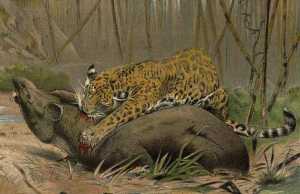
When Anacondas are still young and relatively small, many animals are regarded as predators that will kill and eat them with ease. Among these predators you can name mammals, reptiles, birds and even other snake species. When it comes to adult Anacondas, they are regarded as Power Predators, with very little competition. However, these other Power Predators can technically overpower an Anaconda, but they would usually prefer to hunt for something else. Two Power Predators that are potential dangerous enemies of the Anaconda, are the Caiman (who preys mostly on small Anacondas) and the Jaguar (who preys on big Anacondas). Topping all of these, are of course human beings, who relentlessly hunt for them and are sadly the Anacondas most dangerous predator.
Why do people hunt Anacondas?
People hunt anacondas mainly because of their beautiful skin which is highly desired in the fashion industry.
Why are Anacondas so vulnerable?
One of the most striking Anaconda facts relates to its diet of larger animals. When taking on a very large animal such as Caiman or Capybara, the Anaconda is taking a very big risk that may lead to its injury or even death. How come? Well, when Anacondas attack a large animal, they use their bodies to subdue the prey, and during this constricting fight – the Anaconda is extremely vulnerable to being wounded. A Caiman can easily bite it while fighting. So is the Anaconda a risk-taker as well?
THE AMAZING ANATOMY OF ANACONDA
Are Anacondas strong snakes?
When compared to other boa snakes, the Anaconda’s body is exceptionally stocky and extremely muscular. So yes, it is a very strong snake.
Why are Anacondas called ‘Water Boas”?
Well, as mentioned already – Anacondas love to be in or near water, and on top of that – they are wonderful swimmers and underwater hunters. The reason for that lies in their eyes and nostrils that are located on top of their heads, allowing them to keep their body well hidden underwater, while they can easily breath, see, peek and wait for the perfect catch.
Do Anacondas have teeth?
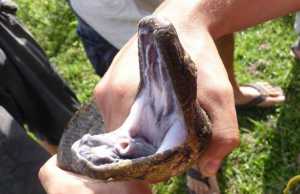
Yes, they do. Anacondas, like most other snakes have four rows of teeth on their upper jaws. The parallel lines of backwards-pointing teeth help the Anaconda to get a grip of its prey and swallow it whole, while the lower jaw adds another two lines of teeth for more support.
How do Anacondas open their mouth so wide?
Well, they have stretchy ligaments in their mouth which hold their jaws together and assist them in opening their mouth wide open to swallow almost any prey they desire, whole.
What is the secret body part of the Anaconda?
It is the only body part of the Anaconda that is scales free. It is the posterior opening of the Anaconda, the only opening for the intestinal, reproductive and urinary tracts. It is the Cloaca. The glands of this body part emit an extremely foul smelling musk that can actually kill small organisms. Some scientists believe that this poisonous must helps the Anaconda deter leeches and small organisms from attaching to its cloaca.
HOW LONG CAN THEY BREATH UNDERWATER? TILL WHEN DO THEY GROW? MORE FASCINATING ANACONDA FACTS!
Until what age do Anacondas grow?
Anacondas don’t really stop to grow. They continue to grow constantly throughout their entire life.
How long can Anacondas stay underwater?
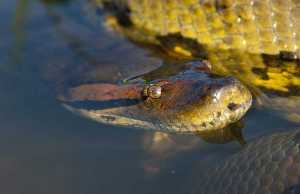
As mentioned earlier, Anacondas LOVE the water, and can stay under for 10 minutes before they need to come up to the surface to grab some air.
How do Anacondas regulate their body temperature?
As mentioned earlier, when Anacondas want to dry off or heat their bodies, they will hang from tree branches, changing the amount of skin surface exposed to the sun. By that they can control and regulate their body temperature.
How do Anacondas react when confronted?
Despite being the largest snake on the planet, the Anaconda does not like to fight. If confronted by enemies – it would rather than attack – choose to escape. Since the Anaconda loves to be near or in swamps, rivers or lakes, water is its main escape route when confronted with danger. It will just slide into the water as quick as possible, and dive away.
How do Anacondas move?
Basically, Anacondas crawl in the same manner any other snake crawls and moves. Their long heavy body, which is composed almost entirely out of muscles, moves in wave-like motion that begins at the front and end at its tail. Anacondas also use the shovel-like body parts called scutes, which are little folds of skin on their underside, to dig into the ground and push themselves forward.
Surprisingly, Anacondas also “sidewind” now and then. “Sidewinding” involves using large J-shaped coils to quickly pull oneself forward. Usually it is smaller snakes that sidewind their way, but it appears that the giant Anaconda is also a fan of this movement technique.
Are Anacondas endangered? Why are they hunted?
As mentioned earlier, Anacondas are hunted mainly for their precious skin which is highly desired in the fashion industry. Luckily, Anacondas are not considered endangered yet. As for now, the skin-trade does not seem to have a significant impact on the species populations. Still, trade in Anacondas is prohibited in most South American countries. Another threat facing Anacondas is their habitat destruction, which slowly causes the decline in their populations.
Are Anacondas good pets?
Anacondas are caught and sold as pets, but this is rare. Very few people adopt Anacondas as pets. Their huge size and aggressive nature makes Anacondas inconvenient pets. They are also extremely difficult to catch.











